Request Board
"Tell me what's great about Osaka!"
"I'm looking for a place to shoot/film!""I'm looking for something in particular!"No matter what your needs...
We're here to help!


Bob's PARTNER
If you're doing work in Osaka, or just have a place you wish everyone knew about, help Osaka Bob help you to spread the word about what you're up to!
Osaka Bob works alongside business supporters to spread word about Osaka to the rest of the world.
ーBob Family WORKS

Pick Up

 And among all the different candies and flavors, Pine Ame remains a crowd favorite. Not just the ladies, but young people all across Japan love Pine Ame. They’re sweet, but tart, and oh so delicious!
And among all the different candies and flavors, Pine Ame remains a crowd favorite. Not just the ladies, but young people all across Japan love Pine Ame. They’re sweet, but tart, and oh so delicious!
 This cute character is one of Osaka Bob’s friends and another local mascot. He’s been featured on our social media accounts before. But he’s been around much longer than Osaka Bob.
Pine Ame has actually been on the market for over 70 years! The packaging design has changed over time. It’s pretty interesting to see the evolution of this famous candy.
[caption id="attachment_7638" align="aligncenter" width="800"]
This cute character is one of Osaka Bob’s friends and another local mascot. He’s been featured on our social media accounts before. But he’s been around much longer than Osaka Bob.
Pine Ame has actually been on the market for over 70 years! The packaging design has changed over time. It’s pretty interesting to see the evolution of this famous candy.
[caption id="attachment_7638" align="aligncenter" width="800"] The evolution of Pine Ame candy[/caption]
Pine Ame is made by a company right here in Osaka. Their corporate headquarters are in Tennoji and the company name is actually Pine Co., LTD. How cute!
The evolution of Pine Ame candy[/caption]
Pine Ame is made by a company right here in Osaka. Their corporate headquarters are in Tennoji and the company name is actually Pine Co., LTD. How cute!
 Pine Ame-kun has a strong presence on social media and sends out interesting posts on a daily basis. Just look at their twitter profile. This candy maker has over 150,000 followers.
Don’t let the spelling fool you... Their handle really is @pain_ame, not because it’s a painful candy, but phonetically transcribing the Japanese characters turns pine into pain. This is not a typo!
Twitter @pain_ame
https://twitter.com/pain_ame
Pine Ame-kun has a strong presence on social media and sends out interesting posts on a daily basis. Just look at their twitter profile. This candy maker has over 150,000 followers.
Don’t let the spelling fool you... Their handle really is @pain_ame, not because it’s a painful candy, but phonetically transcribing the Japanese characters turns pine into pain. This is not a typo!
Twitter @pain_ame
https://twitter.com/pain_ame
 [caption id="attachment_7638" align="aligncenter" width="800"]
[caption id="attachment_7638" align="aligncenter" width="800"] Collaboration between Fueki & Pine Ame[/caption]
〈(Product details here) https://www.pine.co.jp/secret/collaboration/
Pine Ame products are usually bright yellow and they smell great. Use the link above to browse the selection of Pine Ame products available. Did I mention they make a Pine Ame dish soap?
Collaboration between Fueki & Pine Ame[/caption]
〈(Product details here) https://www.pine.co.jp/secret/collaboration/
Pine Ame products are usually bright yellow and they smell great. Use the link above to browse the selection of Pine Ame products available. Did I mention they make a Pine Ame dish soap?
 They also have this slogan that they used in the ’50’s that says something like “When you look through a pine ame candy, what you see on the other side is the future.” That really gets me every time.
Today, and tomorrow, and for the last 70 years, Pine Ame has been delivering juicy flavor and a little pep to mouths all over the country.
They also have this slogan that they used in the ’50’s that says something like “When you look through a pine ame candy, what you see on the other side is the future.” That really gets me every time.
Today, and tomorrow, and for the last 70 years, Pine Ame has been delivering juicy flavor and a little pep to mouths all over the country.
 https://www.pine.co.jp/
▼If you enjoyed this article, read more
https://www.pine.co.jp/
▼If you enjoyed this article, read more
 【OSAKA TRIVIA】One of Japan’s most unique places, Osaka has plenty of interesting trivia
【OSAKA TRIVIA】One of Japan’s most unique places, Osaka has plenty of interesting trivia
2021.06.08Likes 10

 >Osaka e-Pass website
There are some differences in the pricing, admission fees, and participating establishments, but the biggest difference is the transportation charges. The Osaka Amazing Pass allowed you to ride on the Osaka Metro and other train lines for free, but the Osaka e-Pass does not include a transportation pass.
And another thing, you can buy the e-Pass online. Please keep in mind that neither of the passes offer a discounted children’s price.
>Osaka e-Pass website
There are some differences in the pricing, admission fees, and participating establishments, but the biggest difference is the transportation charges. The Osaka Amazing Pass allowed you to ride on the Osaka Metro and other train lines for free, but the Osaka e-Pass does not include a transportation pass.
And another thing, you can buy the e-Pass online. Please keep in mind that neither of the passes offer a discounted children’s price.

 Then enter the number of passes you will purchase.
Then enter the number of passes you will purchase.
 You will need to enter account details, your payment method, and contact information. It’s similar to what you would expect from any online purchase. It takes a few minutes, but it’s easy.
After you register your info, you will receive a notification of your purchase. And that’s it!
You will need to enter account details, your payment method, and contact information. It’s similar to what you would expect from any online purchase. It takes a few minutes, but it’s easy.
After you register your info, you will receive a notification of your purchase. And that’s it!
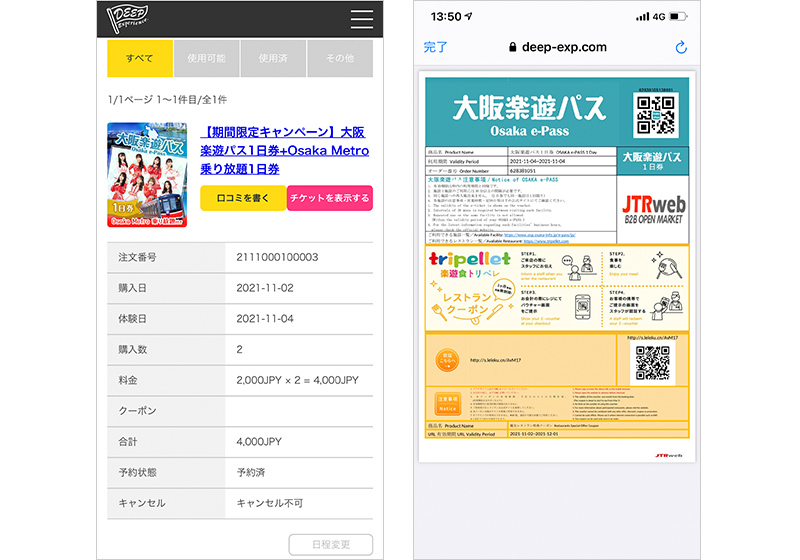 On the top right, there is a QR code, which you show at the reception. The staff uses a special machine to scan the code.
On the top right, there is a QR code, which you show at the reception. The staff uses a special machine to scan the code.
 This is all you have to do!
It’s so easy!
Now, it’s time to take in the museum. The Osaka Museum of Housing and Living is a great place to learn about the history and culture of the city.
This is all you have to do!
It’s so easy!
Now, it’s time to take in the museum. The Osaka Museum of Housing and Living is a great place to learn about the history and culture of the city.
 Currently, part of the museum is under construction so some of the displays are closed. However, it is scheduled to fully reopen by fall 2022.
It’s a bit of a shame that I can’t show you all the museum has to offer, but there is still a lot to see on the 8th floor. When you walk into the exhibition, a huge map of Osaka from 1924 sprawls beneath your feet.
Currently, part of the museum is under construction so some of the displays are closed. However, it is scheduled to fully reopen by fall 2022.
It’s a bit of a shame that I can’t show you all the museum has to offer, but there is still a lot to see on the 8th floor. When you walk into the exhibition, a huge map of Osaka from 1924 sprawls beneath your feet.
 It does feel a little strange to walk on top of a map of the city. Unusual and fun! And on the periphery, showcases display elaborate models of the town and buildings. I was really impressed with the model of the original Tsutenkaku Tower and the amusement park that surrounded it. I didn’t know that area used to have an amusement park!
It does feel a little strange to walk on top of a map of the city. Unusual and fun! And on the periphery, showcases display elaborate models of the town and buildings. I was really impressed with the model of the original Tsutenkaku Tower and the amusement park that surrounded it. I didn’t know that area used to have an amusement park!
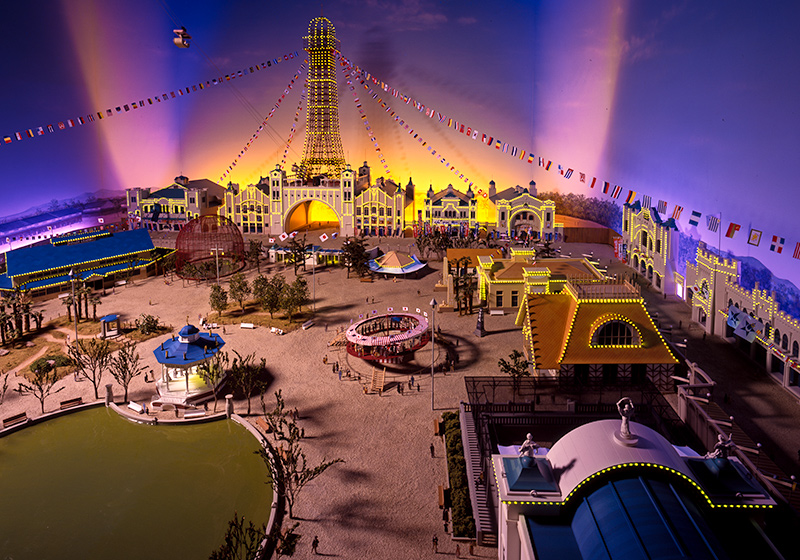 There’s also a model of the famous tea room Sa-an at Gyokurinin Temple. It is so incredibly detailed and surprisingly big too.
There’s also a model of the famous tea room Sa-an at Gyokurinin Temple. It is so incredibly detailed and surprisingly big too.

 When the construction at the museum is complete, I hope to visit again. It should be finished by fall of 2022.
When the construction at the museum is complete, I hope to visit again. It should be finished by fall of 2022.
 Before you go up, you have to go down! The entrance to Tsutenkaku is actually located in the basement.
Before you go up, you have to go down! The entrance to Tsutenkaku is actually located in the basement.
 This is another establishment where admission is easy. You simply show your smartphone to the staff.
This is another establishment where admission is easy. You simply show your smartphone to the staff.
 Then you take the elevator up to the observation deck 87.5 meters (287 feet) aboveground. When you step out, you’ll see Billiken. Go ahead and rub his feet for good luck! Well, actually pre-Covid you could touch his feet, now think of it as an “air rub” like playing air guitar.
Then you take the elevator up to the observation deck 87.5 meters (287 feet) aboveground. When you step out, you’ll see Billiken. Go ahead and rub his feet for good luck! Well, actually pre-Covid you could touch his feet, now think of it as an “air rub” like playing air guitar.

 Walk around the observation deck for views of all directions. It’s really close to Abeno Harukas, so peek out the southeast window for a nice photo of Japan’s tallest building.
Walk around the observation deck for views of all directions. It’s really close to Abeno Harukas, so peek out the southeast window for a nice photo of Japan’s tallest building.
 I decided to pay extra to go on the outdoor observation deck TIP THE TSUTENKAKU. It isn’t included in the e-Pass, but I figured it was worth a few extra yen to climb out on the 92.5 meter (303 feet) tall see-through deck. It definitely was!
I decided to pay extra to go on the outdoor observation deck TIP THE TSUTENKAKU. It isn’t included in the e-Pass, but I figured it was worth a few extra yen to climb out on the 92.5 meter (303 feet) tall see-through deck. It definitely was!
 And here is Tsutenkaku’s rooftop garden.
Most people overlook it, but there is actually a garden on the 3rd floor of the tower.
And here is Tsutenkaku’s rooftop garden.
Most people overlook it, but there is actually a garden on the 3rd floor of the tower.
 Pop in for a look at the Japanese style garden when you’re here!
After a nice lunch in Shinsekai, I headed over to Osaka Castle Park.
The Aqualiner cruise boat departs from a small dock inside the park.
Pop in for a look at the Japanese style garden when you’re here!
After a nice lunch in Shinsekai, I headed over to Osaka Castle Park.
The Aqualiner cruise boat departs from a small dock inside the park.
 The Osaka Castle Pier is located on the north side of the castle, just beyond the cafes and restaurants at Jo Osaka Terrace.
Get your tickets from the reception desk by simply showing your QR code.
The Osaka Castle Pier is located on the north side of the castle, just beyond the cafes and restaurants at Jo Osaka Terrace.
Get your tickets from the reception desk by simply showing your QR code.
 And that’s it. Now we’re ready to board!
And that’s it. Now we’re ready to board!

 The boat is beautiful inside. You’re so close to the water and the boat is completely covered with windows. Look out over the city and view famous landmarks like Osaka Castle and Osaka City Public Hall from the water. This is what it must be like for all the ducks!
And, the boat is climate-controlled, so it will be a comfortable cruise whenever you visit. This is a great way to explore Aquametropolis Osaka.
The boat is beautiful inside. You’re so close to the water and the boat is completely covered with windows. Look out over the city and view famous landmarks like Osaka Castle and Osaka City Public Hall from the water. This is what it must be like for all the ducks!
And, the boat is climate-controlled, so it will be a comfortable cruise whenever you visit. This is a great way to explore Aquametropolis Osaka.
 The pass will also get you admission to the Osaka Castle Museum and the Gozabune cruise around the castle moat. But I chose this longer river cruise today.
Oh, and there’s one more place I wanted to visit!
The pass will also get you admission to the Osaka Castle Museum and the Gozabune cruise around the castle moat. But I chose this longer river cruise today.
Oh, and there’s one more place I wanted to visit!
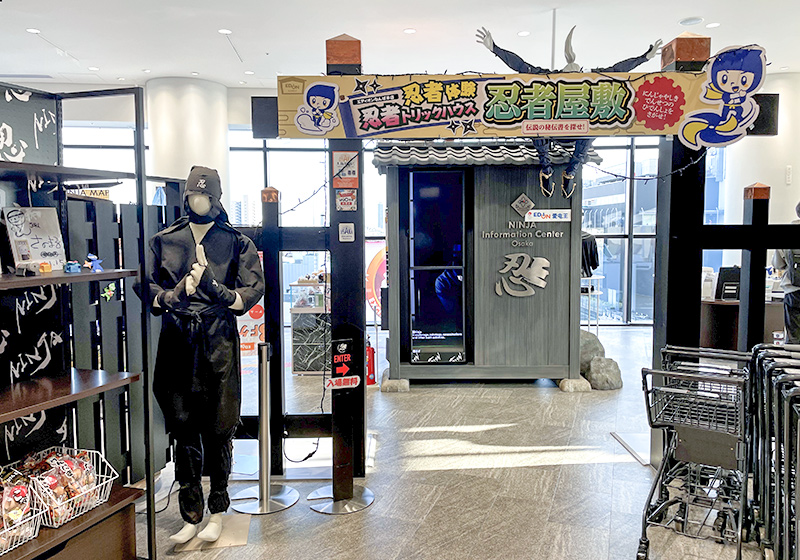 I won’t go into too many details and spoil all the fun, but here is a glimpse of the ninja experiences waiting for you here.
Children and those young at heart will love solving mysteries and finding the scrolls hidden in the ninja house. There is a time-limit so you have to work fast!
I won’t go into too many details and spoil all the fun, but here is a glimpse of the ninja experiences waiting for you here.
Children and those young at heart will love solving mysteries and finding the scrolls hidden in the ninja house. There is a time-limit so you have to work fast!
 And you can practice throwing ninja stars.
And you can practice throwing ninja stars.
 It’s harder than it looks🤨
I started the day with the Osaka Museum of Housing and Living, moved on to Tsutenkaku and then cruised the city’s rivers on the Aqualiner before exploring the Ninja Information Center. That’s 4 so far, but how about one more?
I headed up to Umeda for a whirl on the HEP FIVE Ferris Wheel.
It’s harder than it looks🤨
I started the day with the Osaka Museum of Housing and Living, moved on to Tsutenkaku and then cruised the city’s rivers on the Aqualiner before exploring the Ninja Information Center. That’s 4 so far, but how about one more?
I headed up to Umeda for a whirl on the HEP FIVE Ferris Wheel.
 It’s another one of Osaka’s famous landmarks, and the bright red wheel visible from most parts of Umeda.
It’s another one of Osaka’s famous landmarks, and the bright red wheel visible from most parts of Umeda.

 There’s nothing like riding a Ferris wheel right in the middle of a city.
You get great views of Osaka Station and the city skyscrapers. Plus, you can see as far as Mt. Ikoma off in the distance. The station was perfectly backlit by the sunset when I visited. It’s nice all day, but dusk is particularly beautiful.
There’s nothing like riding a Ferris wheel right in the middle of a city.
You get great views of Osaka Station and the city skyscrapers. Plus, you can see as far as Mt. Ikoma off in the distance. The station was perfectly backlit by the sunset when I visited. It’s nice all day, but dusk is particularly beautiful.


2021.11.17Likes 11
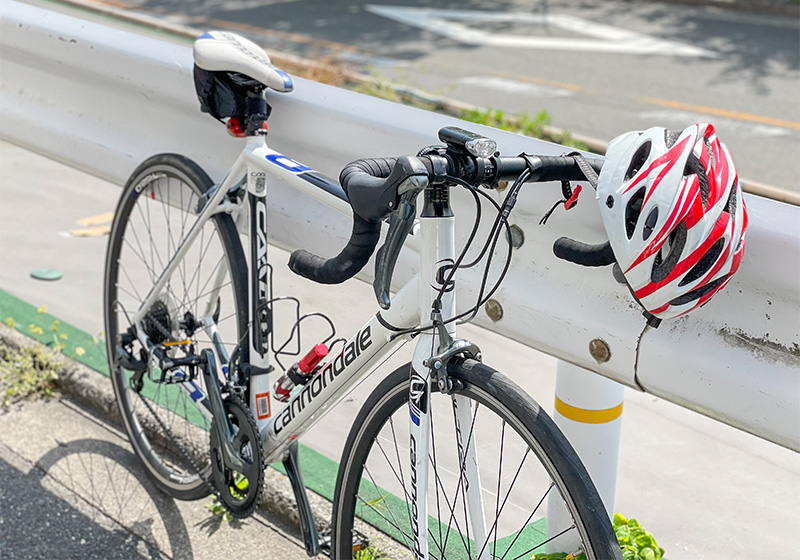 On Japanese streets you’ll see a lot of what are called “Mama-chari,” essentially utility bicycles often equipped with child seats and baskets. These can weigh up to 20kg! But the road bike, the beautiful road bike, weighs in at about 6–10kg. Materials like aluminum, chromoly, and titanium keep them nice and light, and smooth to ride.
On Japanese streets you’ll see a lot of what are called “Mama-chari,” essentially utility bicycles often equipped with child seats and baskets. These can weigh up to 20kg! But the road bike, the beautiful road bike, weighs in at about 6–10kg. Materials like aluminum, chromoly, and titanium keep them nice and light, and smooth to ride.
 See! They’re so easy to pick up!
They’re light to pedal and of course, these bikes have a few gears on them so you can adjust your setting to match the road conditions.
This is a great way to explore the city. And if you're interested in buying a road bike, but want to try riding one firsttry renting one first.
See! They’re so easy to pick up!
They’re light to pedal and of course, these bikes have a few gears on them so you can adjust your setting to match the road conditions.
This is a great way to explore the city. And if you're interested in buying a road bike, but want to try riding one firsttry renting one first.

 Here are all their beautiful bikes! There’s a lot to choose from!
The owner, Gareth, hails from the UK. He began backpacking after graduating from university his adventurous spirit led him on tours of South America, Asia and Australia. He’s a really nice guy, so feel free to ask him anything you’re curious about.
Here are all their beautiful bikes! There’s a lot to choose from!
The owner, Gareth, hails from the UK. He began backpacking after graduating from university his adventurous spirit led him on tours of South America, Asia and Australia. He’s a really nice guy, so feel free to ask him anything you’re curious about.
 When he arrived in Japan he had plans to continue his travels, but he liked it so much here that he decided to stay. While working as an English teacher he had the chance to tour Japan on his road bike and saw many of the beautiful sights Japan has to offer.
A strong desire to share the joys of cycling in Japan with locals and tourists alike inspired him to open a bicycle rental business.
Let’s see what we can see after renting a bike from his shop. First, you want to make sure you have a bike that fits you. If the bike is too big or too small for you, you won’t be able to pedal smoothly. So we’re looking for bikes that are the right size and then do some fine adjustments with the seat to get it at the perfect height.
When he arrived in Japan he had plans to continue his travels, but he liked it so much here that he decided to stay. While working as an English teacher he had the chance to tour Japan on his road bike and saw many of the beautiful sights Japan has to offer.
A strong desire to share the joys of cycling in Japan with locals and tourists alike inspired him to open a bicycle rental business.
Let’s see what we can see after renting a bike from his shop. First, you want to make sure you have a bike that fits you. If the bike is too big or too small for you, you won’t be able to pedal smoothly. So we’re looking for bikes that are the right size and then do some fine adjustments with the seat to get it at the perfect height.
 Afterwards, Gareth shared some basic rules about shifting gears. This is important when you’re climbing a hill, so listen carefully!
Afterwards, Gareth shared some basic rules about shifting gears. This is important when you’re climbing a hill, so listen carefully!
 There were a few other minor preparations before we left, which might be difficult for a beginner cyclist. Fortunately, we had Gareth there to help us at every step of the way.
The bike comes equipped with a helmet, bottle cage, light, lock, saddle bag, spare tube, pump, and a multi-tool. That means all you have to worry about is wearing comfortable clothes and bringing a drink.
I brought two friends along this was their first time riding a road bike.
There were a few other minor preparations before we left, which might be difficult for a beginner cyclist. Fortunately, we had Gareth there to help us at every step of the way.
The bike comes equipped with a helmet, bottle cage, light, lock, saddle bag, spare tube, pump, and a multi-tool. That means all you have to worry about is wearing comfortable clothes and bringing a drink.
I brought two friends along this was their first time riding a road bike.

 So that’s it! Helmets on and we’re off.
So that’s it! Helmets on and we’re off.
 Since the terrain is relatively flat, it was easy riding. And this was a good place to practice all the gear-changing that Gareth taught us about. Riding along the river, we could really unwind.
Since the terrain is relatively flat, it was easy riding. And this was a good place to practice all the gear-changing that Gareth taught us about. Riding along the river, we could really unwind.
 We headed over to Sakuranomiya Bridge aka Ginbashi (Silver Bridge), as it’s known for its silver color.
The breeze feels so good when you’re on the river and we loved how light and easy it was to pedal the road bikes.
On the west bank of the river we found a brick building with a spiral staircase. This is the kind of thing you notice when you’re on a bike.
We headed over to Sakuranomiya Bridge aka Ginbashi (Silver Bridge), as it’s known for its silver color.
The breeze feels so good when you’re on the river and we loved how light and easy it was to pedal the road bikes.
On the west bank of the river we found a brick building with a spiral staircase. This is the kind of thing you notice when you’re on a bike.
 We would have sped right by without giving it a second glance if we’d been in a car. And I doubt we would have walked this far on foot. This must be the joy of cycling Gareth was talking about.
Next we passed in front of the Japan Mint and Tenmabashi Bridge. Then we headed to Osaka Castle. This is a little known spot that has beautiful sunsets. There are people who wake up early on New Year’s Day to see the first sunrise here. The sun comes up between the castle tower and Osaka Business Park.
We would have sped right by without giving it a second glance if we’d been in a car. And I doubt we would have walked this far on foot. This must be the joy of cycling Gareth was talking about.
Next we passed in front of the Japan Mint and Tenmabashi Bridge. Then we headed to Osaka Castle. This is a little known spot that has beautiful sunsets. There are people who wake up early on New Year’s Day to see the first sunrise here. The sun comes up between the castle tower and Osaka Business Park.
 Heading towards Osaka Castle, we crossed another bridge. Osaka is really easy to cycle because it’s so flat, except for the bridges. They take a little effort to get up, but these road bikes are really easy to ride. Way faster than the mama-chari’s my friends are used to.
The other nice thing about being on a bike, is that even if you make a wrong turn, you can make up the distance quickly. It’s hard to put into words, but riding around around is so relaxing. All three of us were carefree cruising on our road bikes.
And then we arrived at the castle.
Heading towards Osaka Castle, we crossed another bridge. Osaka is really easy to cycle because it’s so flat, except for the bridges. They take a little effort to get up, but these road bikes are really easy to ride. Way faster than the mama-chari’s my friends are used to.
The other nice thing about being on a bike, is that even if you make a wrong turn, you can make up the distance quickly. It’s hard to put into words, but riding around around is so relaxing. All three of us were carefree cruising on our road bikes.
And then we arrived at the castle.
 Osaka Castle Park has amazing stone walls. Just look how big these are. Absolutely massive!
This is the Kyobashi-guchi Gate on the northwest side of the castle. The rock known as Higoishi is 33 times the size of a tatami mat.
Riding bikes on the castle grounds is fun too!
Osaka Castle Park has amazing stone walls. Just look how big these are. Absolutely massive!
This is the Kyobashi-guchi Gate on the northwest side of the castle. The rock known as Higoishi is 33 times the size of a tatami mat.
Riding bikes on the castle grounds is fun too!
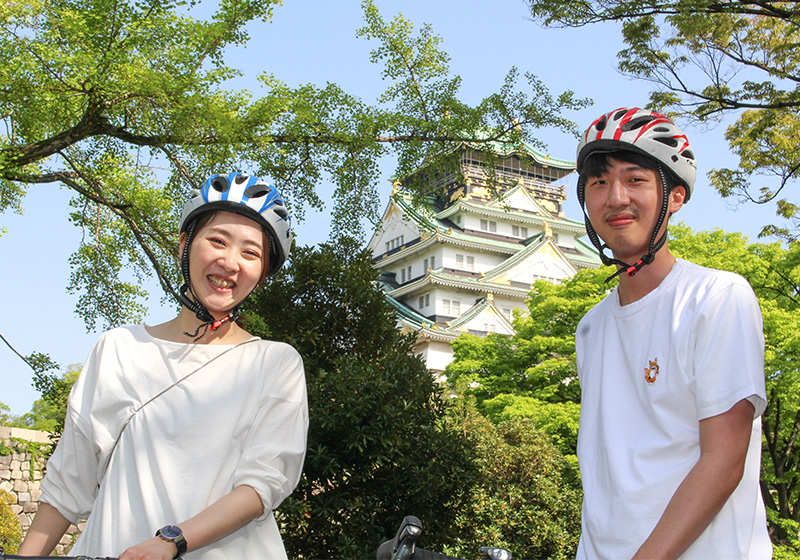 We got up close to the tower for a shot with the castle. Cheese!
Then we stopped for a much needed break. Not that we were tired of riding, just that we wanted to stop and rehydrate. Make sure you take breaks and drink enough fluid while you’re cycling. Especially if it’s hot out!
We got up close to the tower for a shot with the castle. Cheese!
Then we stopped for a much needed break. Not that we were tired of riding, just that we wanted to stop and rehydrate. Make sure you take breaks and drink enough fluid while you’re cycling. Especially if it’s hot out!
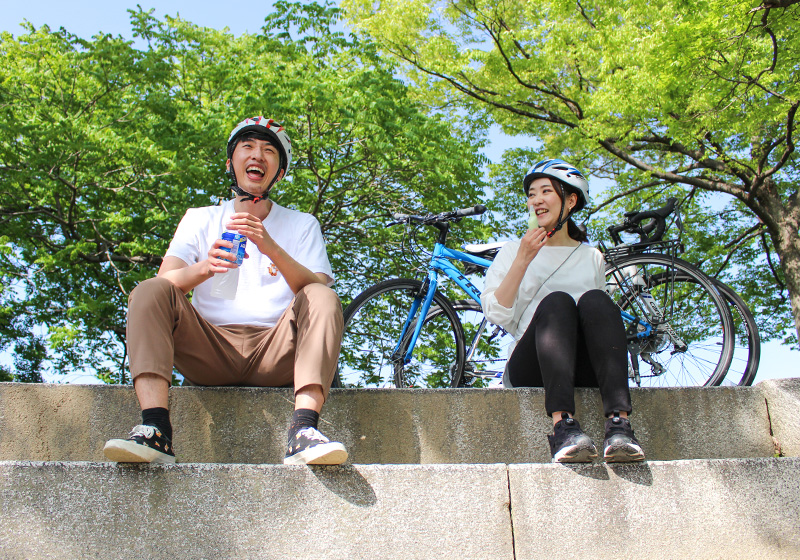 The park is huge so there is a lot to explore.
The park is huge so there is a lot to explore.
 Then we went through the impressive Aoyamon Gate.
Then we went through the impressive Aoyamon Gate.
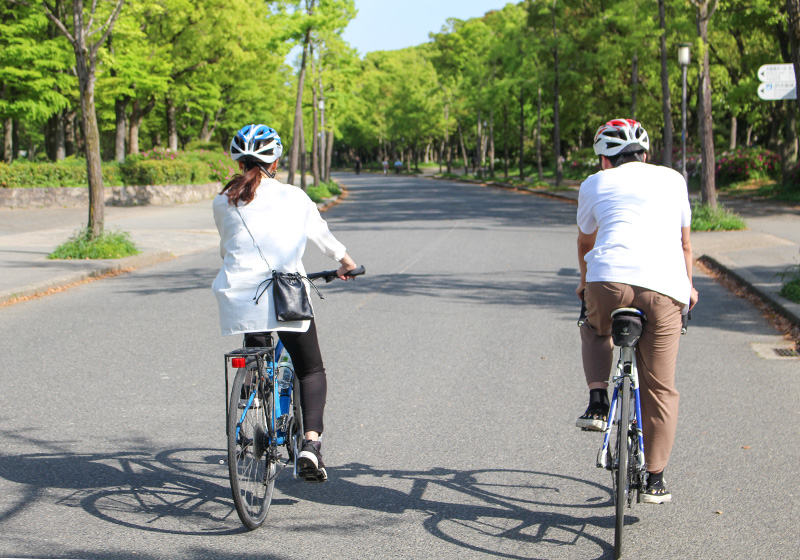 Osaka Castle Park is great for cycling because the paths are wide and there are no cars. The long course around the castle is about 3.5km.
We stopped at the nearby YTV building to take a picture with the Detective Conan statue and then headed back to the river. It was so much fun to visit so many places by bicycle.
Osaka Castle Park is great for cycling because the paths are wide and there are no cars. The long course around the castle is about 3.5km.
We stopped at the nearby YTV building to take a picture with the Detective Conan statue and then headed back to the river. It was so much fun to visit so many places by bicycle.
 When you’re on a bike, Osaka doesn’t feel that big at all, especially if it’s a road bike. This is a great way to cover a lot of ground sightseeing.
We headed back to Road Bike Rental Japan. I have to say, I was a little worried we would get tired on our trip, but it was way easier on the legs than I had imagined.
And Gareth was waiting for us when we got back to the shop.
When you’re on a bike, Osaka doesn’t feel that big at all, especially if it’s a road bike. This is a great way to cover a lot of ground sightseeing.
We headed back to Road Bike Rental Japan. I have to say, I was a little worried we would get tired on our trip, but it was way easier on the legs than I had imagined.
And Gareth was waiting for us when we got back to the shop.
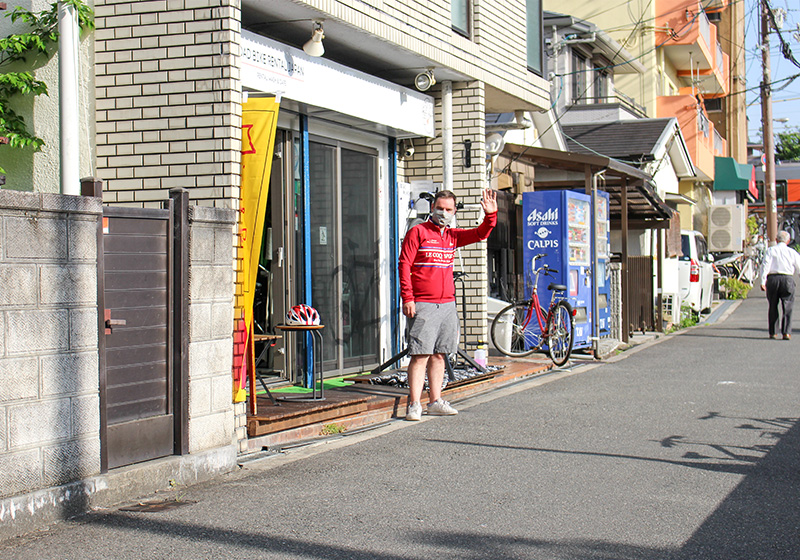
 Official website▶https://roadbikerentaljapan.com/
Reservations are easy to make and the site includes all you need to know about preparing for your ride, rental hours, payment methods, and everything else on the FAQ section.
Look here to find out more!
Official website▶https://roadbikerentaljapan.com/
Reservations are easy to make and the site includes all you need to know about preparing for your ride, rental hours, payment methods, and everything else on the FAQ section.
Look here to find out more!
 After you make a reservation, just show up at the shop on the day you booked. From there, it should go as smoothly as I described above.
Oh, and there is one more very special thing about RBRJ!
The
After you make a reservation, just show up at the shop on the day you booked. From there, it should go as smoothly as I described above.
Oh, and there is one more very special thing about RBRJ!
The
 ▲Road Bike Rental Japan homemade waffles[/caption]
This hit the spot after a day of cycling. The cafe is a great place to grab a coffee before you head out too!
[caption id="attachment_12020" align="alignleft" width="800"]
▲Road Bike Rental Japan homemade waffles[/caption]
This hit the spot after a day of cycling. The cafe is a great place to grab a coffee before you head out too!
[caption id="attachment_12020" align="alignleft" width="800"] ▲Road Bike Rental Japan coffee mugs[/caption]
These are the cutest!♥
▲Road Bike Rental Japan coffee mugs[/caption]
These are the cutest!♥
 The best way to keep your road bike looking good for a long time is to put the time in to care for it properly.
If you have your own bike, stop in for a wash or borrow their equipment for ¥100/10 min. What a nice service for local bike enthusiasts. They’ve even got a DIY bike maintenance studio, so feel free to pop in and work on your own bike.
The best way to keep your road bike looking good for a long time is to put the time in to care for it properly.
If you have your own bike, stop in for a wash or borrow their equipment for ¥100/10 min. What a nice service for local bike enthusiasts. They’ve even got a DIY bike maintenance studio, so feel free to pop in and work on your own bike.



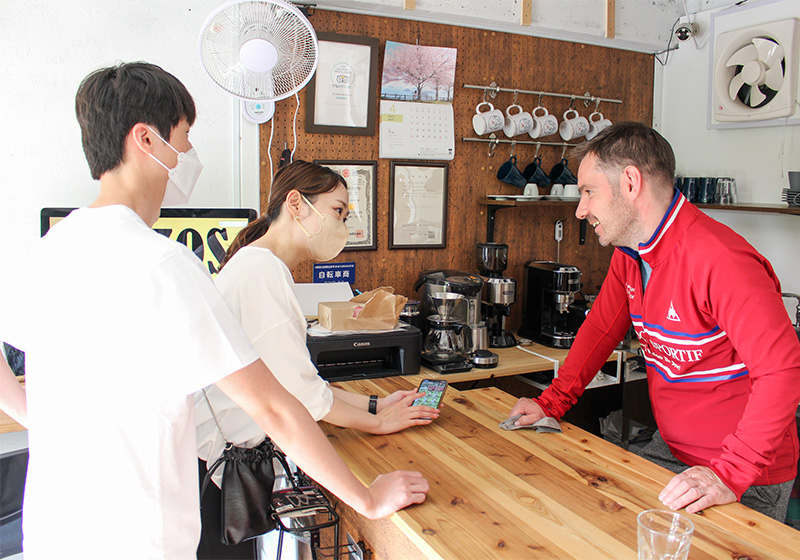 The owner, Gareth was so kind and friendly. He have us advice on our route before we left.
He recommends a trip out of the city to Arashiyama in Kyoto, or Katsuoji Temple in Minoh. A trip outside of the city to breath fresh air and take in new scenery is so refreshing. He told us
“That’s the best medicine for the stress that we carry with us in our busy day-to-day lives.” Our ride convinced me. I think he’s right!
A group ride with friends is a great way to share some fun time together. Solo riding gives you a chance to make time for yourself. A bike adventure really is so freeing.
Try it! Explore Osaka on a bike from Road Bike Rental Japan.
The owner, Gareth was so kind and friendly. He have us advice on our route before we left.
He recommends a trip out of the city to Arashiyama in Kyoto, or Katsuoji Temple in Minoh. A trip outside of the city to breath fresh air and take in new scenery is so refreshing. He told us
“That’s the best medicine for the stress that we carry with us in our busy day-to-day lives.” Our ride convinced me. I think he’s right!
A group ride with friends is a great way to share some fun time together. Solo riding gives you a chance to make time for yourself. A bike adventure really is so freeing.
Try it! Explore Osaka on a bike from Road Bike Rental Japan.
 Start your adventure here!
▼Enjoy this article? Read more!
Start your adventure here!
▼Enjoy this article? Read more!
 I’m walking on sunsets!
A trip through Yuhigaoka
I’m walking on sunsets!
A trip through Yuhigaoka
2022.04.28Likes 7
Register as a business supporter and create your own original page!
Business Supporter RegistrationRequest Board
"Tell me what's great about Osaka!"
"I'm looking for a place to shoot/film!""I'm looking for something in particular!"No matter what your needs...
We're here to help!

